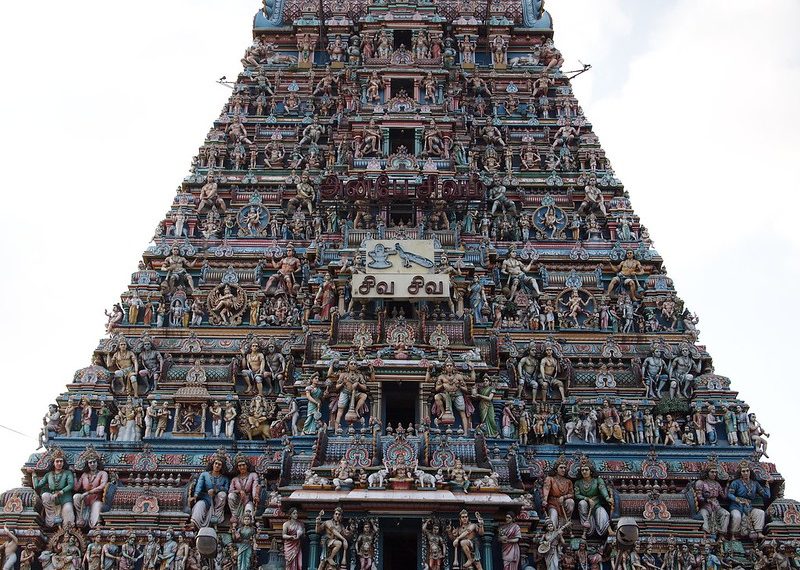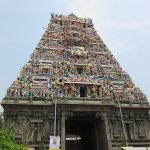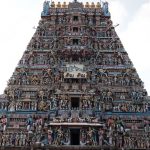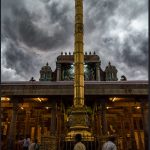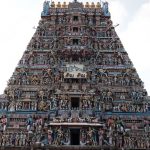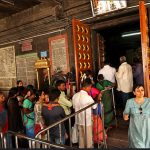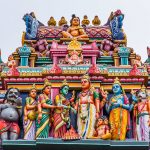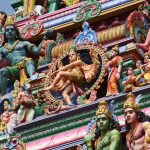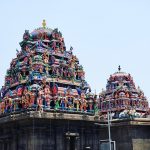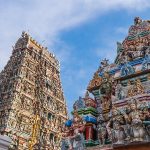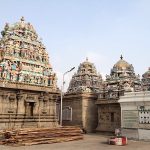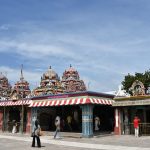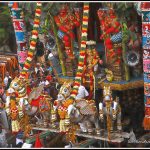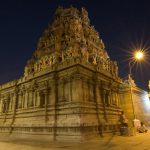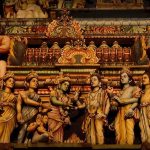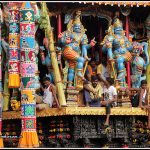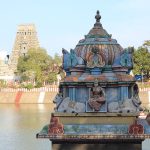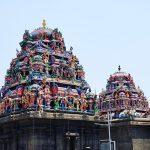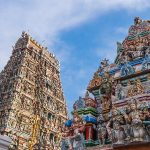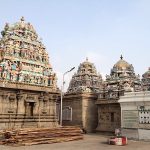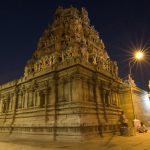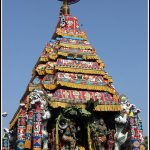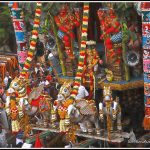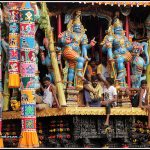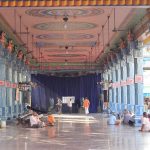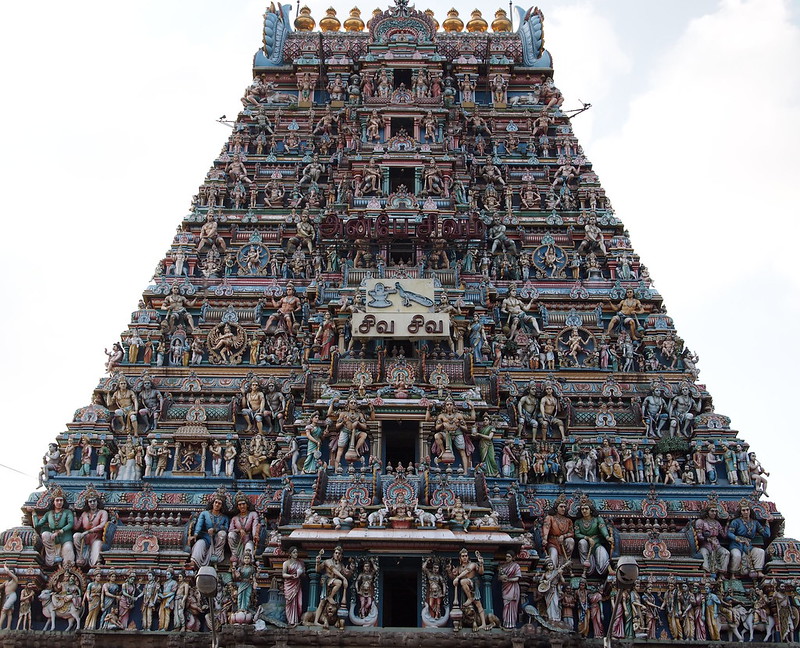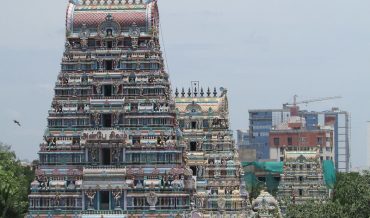
Main Deity – Kapaleeshwarar Temple
Main Deity: Kapaleeshwarar (Bhagwan Shiva)
Consort: Karpagambal (Maa Parvati)
Sthal Vriksh: Punnai Tree (Calophyllum inophyllum is also known as Alexandrian laurel)
Sthal Theerth: Kapali, Kadavul, Veda, Vali, Ganga, Velli, and Rama Theertham
The Kapaleeshwarar Temple is of typical Dravidian architecture style, There are 2 entrances to the Temple marked by the Gopuram on either side with the Gopuram overpowering the street on which the Temple present. The East Gopuram is about 40 m height, while the smaller western Gopuram faces the Holy Pond, with intricate patterns of sculpture figures in cool eye-passing colors is a treat to watch. The Temple is also a testimonial for the Vishwakarmas Sthapathis. There are inscriptions on the Temple Structure which dates to the 7th Century. The Temple faces East and the entrance is marked in Pauranika inscriptions. The view of the Temple from the outside is magnificent and awesome. The current Temple is a modern structure, built based on the descriptions in the Pauranika and the Thevaram; the huge Temple pond is the site of the popular Theppam festival in the month of Tamil month Thai (Jan-Feb).
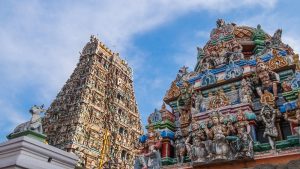
Inside view of Gopuram – Kapaleeshwarar Temple
As you enter the Temple you can view the sculpture of a holy Sage GnanaSambandhar. Other than this, you can see the bronze carvings of the 63 Nayanmars, which are carried on the 8th day of the 10-days long procession during the Arupathimoovar festival, which is in Mar-Apr. In the courtyard of the Temple there is Sthal Vriksh Punnai Tree, which is one of the oldest trees of Chennai. There is also a peacock and a peahen caged inside the Temple, to symbolize the tradition that Karpagambal had come in the form of peahen to plead Kapaleeshwarar.
Poompavai has her shrine near the West Gopuram. This is also the birth place of Vaayilar Nayanar, one of the 63 Nayanars. He too has his shrine in the Temple. The Singaravelar shrine is where Shri Subrahmaniya is said to have been given the Vel by His Mother. Bhagwan Muruga as Singaravelan praised by Sage Arunagirinathar in ten of his celebrated Thirupugazh hymns. There is one more courtyard that houses the shrines of 63 Nayanmars.
Here we learn the Sattology behind Kapaleeshwarar Temple
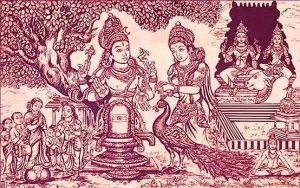
Sketch – Goddess Karpagambal
According to Sattology, Kapaleeshwarar Temple is one of the prominent Shiva Temples in India situated in Mylapore, Chennai. Here Bhagwan Shiva is worshiped as Kapaleeshwar (Swambhu) and Maa Shakthi as Karpagambal. There is a Pauranik behind how the place got the name Mylapore and the same story is the root of this magnificent pilgrim center. According to the Sattology, Goddess Karpagambal wished to know the meaning of the five lettered divine mantra “Na Ma Shi Va Ya”. She pleaded to Bhagwan Shiva to teach her the true meaning of the mantra along with the significance of Holy Ash. He agreed and once while he was teaching the same to Uma Devi, her eyes fall upon a beautiful peahen dancing and lost her concentration. Bhagwan Shiva displeased by her, cursed her to become a peahen. In order to free herself from the curse she was asked to go to Earth and do penance on him. Therefore Goddess Karpagambal worshiped the Shivalinga under the Punnai tree here where the Temple stands. Pleased by her devotion, Bhagwan Shiva freed the Goddess from the curse and she regained her original form. This is how the place came to be known as Mylapore [Mayil – Peacock in Tamil] where Goddess Karpagambal in her peacock form worshiped the Shivalinga and freed herself from the curse. 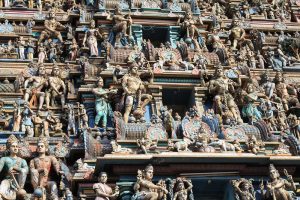
The Temple was built on the seashore around 7th Century CE in Pallavas architecture; but was destroyed by the Portuguese when Mylapore fell into their hands in 1566 AD. The present architecture; structure was built during the Vijayanagara rulers of the Tuluva Dynasty (1491-1570 CE)
There are many Pauranik Itihas that proves the significance of this Kapaleeswarar Temple. Lord Muruga, son of Lord Shiva visited this Temple and worshiped Him and His Mother Goddess Uma (Karpagambal) before heading to a war with an Asura (demon) named Surapadman. He received the Shaktivel here at this Temple, a divine powerful weapon his Mother gave to fight the Asura.
Now there is another fascinating Sattology of why Lord Shiva is known as Kapaleeshwarar. Once Lord Brahma, the creator as per Hindu Sattology, considered him greater than Lord Shiva as he too had five heads and then Lord Shiva in order to teach Brahma a lesson of humility, nipped one of the five heads of Brahma and held his skull in his hand, earning himself the name Kapaleeshwarar for Kapalam in Sanskrit means Skull.
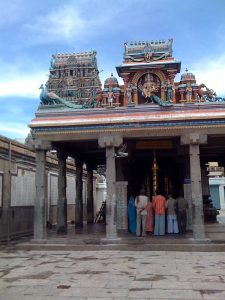
Lord Muruga Shrine – Kapaaleeshwarar Temple
Sattology behind Architecture of the Temple
Now moving on the architecture of the Temple, it is another great piece of Dravidian art, but it is not the original structure of the Temple which is long gone or washed ashore. Even the great historians are not able to date the construction of the original Temple. The Temple authorities claim that the original Temple was destroyed by the Portuguese. The current structure is more than 300 years old.
The Shiva Lingam worshiped here is a Swayambhu Lingam, which means it is a self-manifested lingam. It is one among the 64 Swayambhu Lingams in the world. Other than the main deities Kapaleeswarar and Karpagambal, there are various other shrines of Nartana Vinayakar, Palani Andavar, Vaayilar Nayanar, Singara Velar, Dakshinamurthy, Somaskandar and Durga. There is another small shrine outside, at the courtyard of the Temple and under the old Punnai tree depicting Goddess Uma in the form of a peacock worshiping Lord Shiva, which remind us the Itihas of how this place got its name “Mylapore”.
The famous Temple finds in the 7th Century Shaiva Canocical work, the Thevaram, written by Tamil sage poets known as Nayanmars and classified as one of the 275 Paadal Petra Sthalams and 24th Shiva Sthalam in Tamil Nadu. The Temple and the deity were immortalized in the works of Thevaram by poet-sage belonging to the 7th century; Thirugnana Sambandar has composed the 6th Poompavai Pathigam in praise of the Temple. Arunagirinathar, the 15th Century poet sang praises of the Temple in Thirumayilai Thirupugazh.
Sattology of the original Temple which was destroyed by Portuguese
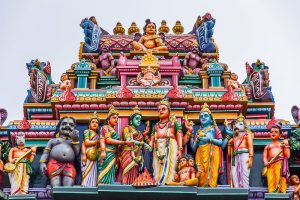
Gopuram Carvings
Ptolemy, the Greek Geographer (A.D. 90-168) has referred to Mylapore in his books as ‘Millarpha’. It was apparently a well-known sea port town with a flourishing trade. It must have also been a place of culture, as Sage & Poet Tiruvalluvar the celebrated author of Tirukkural, the World-famous ethical treatise, lived in Mylapore nearly 2,000 years ago. The Saivite Sages of the 7th Century, Sage Sambandar and Sage Appar, have sung about the Shrine in their hymns.
St. Thomas, one of the apostles of Jesus, is reported to have visited Mylapore in the 2nd Century AD. His tomb is in the St. Thomas basilica, a beautiful cathedral about half a mile from the Temple. The commonly held view is that the Temple was built in the 7th Century CE by the ruling Pallavas.
This view is based on references to the Temple in the hymns of the Nayanmars (which however, place it by a sea shore). Thirugnana Sambandar’s 6th song in Poompavai Pathigam and Arunagirinathar 697th song in Thirumayilai Thirupugazh, make clear references to the Kapaleeshwarar Temple being located on the seashore of Mylapore. The scholarly view that accounts for the discrepancies is that the original Temple was built on the shore but was destroyed by the Portuguese (present day Santhome Church) in 1566 AD. and the current Temple (which is 1.5 kms from the shore) was built by the Vijayanagara kings during the 16th Century, using some remains of the Old Temple.
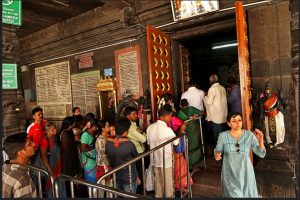
Inner Sanctom
There are some fragmentary inscriptions from the old Temple, still found in the present Shrine and in St. Thomas Cathedral. The existing structure of the Temple is only 300 years old. According to the Temple authorities, the old Kapaleeshwarar Temple was in Santhome Beach, which was destroyed by the Portuguese. There are inscriptions dating back to 12th Century inside the Temple. The Temple’s 120 ft. Gopuram was built during 1906 with stucco figures adorning it. The Temple is maintained and administered by the Hindu Religious and Endowment Board of the Government of Tamilnadu
Devotees pray here to get satisfaction in their life
Devotees pray to Bhagwan for mental peace / satisfaction and Mother Karpagambal for child, wedding and family welfare. It is the staunch belief of devotees that their prayer brings them relief from any illness. Those suffering from any disease, carry sugar in a pot and distribute to devotees on the 8th day of Thaipoosam festival. They perform Abhishekam and Aaradhanas to Goddess offering vastras.
Here we go with our Happiest moments by experiencing the celebrations of Festivals in our Temple
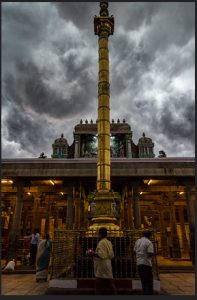
Dwaja Sthambam – Kapaleeshwarar Temple
During the Tamil month of Panguni (Mar-Apr), the traditional Brahmotsavam takes place when the entire neighborhood comes alive with a Mela. Since this month corresponds to the Mar-Apr duration, the Kapaleeshwarar Temple celebrates the nine day-long as Panguni Peruvizha (Spring festival). The festival starts with Dwaja Rohanam (flag hoisting), includes Therottam (Rath Yatra) Arupathimoovar festival and concludes with the Thirukalyanam (Marriage of Kapaleeshwarar and Karpagambal).
In Brahmotsavam, the idols of Kapaleeshwarar and Karpagambal are decorated with clothes and jewels, are mounted on a vahana, and then taken around the Temple and its water pond in a Pradakshinam. This is repeated with different vahanas over the next nine days. The more important of the individual pradakshinams are the Adhikara Nandhi on the 3rd day. the Rishabha Vahanam on the midnight of the 5th day, the Ther (Rath Yatra) (About 13 meters in height and pulled by people) on the 7th day morning and the Arupathimoovar festival on the 8th day.

Rath Yatra – Kapaleeshwarar Temple
The Arupathimoovar festival is the most important procession. It is named after the 63 Nayanmars who attained Moksha by their true Bhakthi to the all compassionate Bhagwan Shiva. All 63 Nayanmars idols follow the Kapaleeshwarar idol on this procession. During the Chariot festival, Kapaleeshwarar is depicted holding a bow while seated on a throne, with His Consort Karpagambal alongside. Brahma is depicted riding the Chariot (Rath). The chariot is decorated with flowers and statues and there are huge gatherings of devotees to pull the Rath. The Rath Yatra of 1968 is documented in the documentary film Phantom India by Louis Malle.
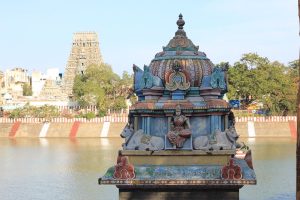
Temple Pond – Kapaleeshwarar Temple
The Temple’s pond in front of the West Gopuram is used to celebrate the Float Festival, which is held in Jan or Feb. Each Full Moon day is a day of special poojas to Bhagwan and Mother Karpagambal. As the divine Karpaga Tree offers all wishes to a devotees, Maa Ambica offers all that her devotees wishes, hence praised as Karpagambika. The devotees crowd in the Temple is usually huge on Amavasya, Poornima and Pradosha days. Bhagwan Shiva related festivals are observed in the Temple each month.
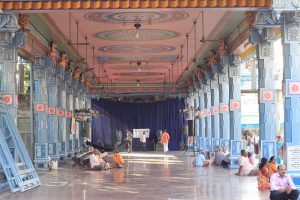
Temple Mandap
How to reach the Temple: Location from Google Maps – Click Here
Source Information: From Temple website & my known knowledge
Image Source: Google & Sri. Arun Prasad
Please watch a video clip of Kapaleeshwarar Temple for better understanding.
- Gopuram – Kapaleeshwarar Temple
- Gopuram – Kapaleeshwarar Temple
- Dwaja Sthambam – Kapaleeshwarar Temple
- Carvings on Gopuram
- Gopuram
- Inner Sanctom
- Carvings on Gopuram
- Carvings on Gopuram1
- Carvings on Gopuram
- Inner Shrines
- Inside view of Gopuram – Kapaleeshwarar Temple
- Inner Shrines
- Inner Shrines
- Lord Muruga Shrine – Kapaaleeshwarar Temple
- Decoration of Rath during Festivals
- Chariot
- Inside view of Temple during night time
- Meenakshi Sundareswarar Marriage Carving on Gopuram
- Carvings on Rath
- Temple Pond
- Main Deity – Kapaleeshwarar Temple
- Inner Shrines
- View of Gopuram from Inside
- Inner Shrines
- Night View
- Rath or Chariot
- Carvings on Chariot
- Carvings on Chariot
- Mandap
All information entered is personal to the author. Any modification or changes must be addressed to the author.

